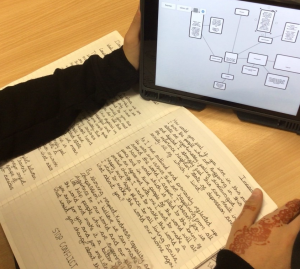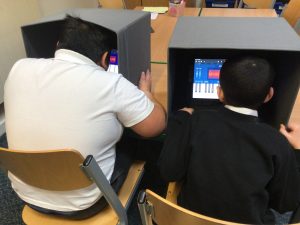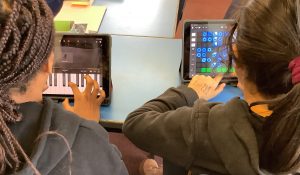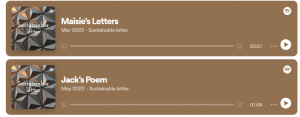
March 27, 2023, by Rupert Knight
Spreading the Word: Podcasting in the Primary Classroom
In this blog, Jenny Hinton from Parkdale Primary School in Nottingham shares her experiences of integrating technology and, more specifically, podcasting in the classroom.
An informed approach to integrating technology in the classroom
At Parkdale, we’re proud of our digital journey! In my role as Digital Lead and Teaching & Learning Lead, I have an ever-growing passion for exploring ways in which technology can purposefully redefine learning experiences in the classroom.
When integrating technology, as educators, it’s always essential to consider the ‘why this & why now’ questions – as we do with all our choices – for meaningful implementation and maximum impact. When making decisions to integrate iPads in a classroom, the rationale needs to extend beyond novelty and engagement to be transformative over a sustained period. Models which we’ve found valuable to focus a more insightful reflection process include the TPACK model and the SAMR model.
TPACK refers to the types of knowledge which we require when designing teaching and learning using technology:
• Technological Knowledge
• Pedagogical Knowledge
• Content Knowledge
When teachers are competent in each knowledge area and combine them when making decisions, it’s often referred to as achieving the ‘sweet spot’ for intentional and impactful integration of technology. This is our goal!
The SAMR (Substitution, Augmentation, Modification, Redefinition) model outlines ways we use technology as a tool. It’s important to note that although technology has the power to redefine learning, there’s also value in using it as a substitution tool – if we’re aware that’s all it’s achieving! For example, typing writing rather than handwriting could be considered as substituting pen and paper, but may also improve the accessibility of the task for pupils as they may be able to use dictation to help them write and ‘speak screen’ to help them check their writing. This overlaps with augmentation as the design has functional improvement.
As a leader of digital integration, I have used these models to provide our staff with the core elements to consider when reflecting upon their planning and implementation of digital. Greater use of these models has supported staff in being more intentional in the use of digital technology and has contributed to a development of strong pedagogical choices, rather than novelty!
It’s time to think differently…

Utilising our knowledge of pupils’ interests has always been considered as a route to engaging pupils. With that in mind, our pupils – otherwise known as digital natives – are learning in an environment which is also a rapidly transforming digital world. Tapping into this growing knowledge and interest of many pupils often creates more accessible and personalised pathways which may not have previously been possible, whilst also being a powerful and authentic engagement tool.
At Parkdale, our ‘why’ for integrating podcasting extends beyond academic attainment. As teachers, we must create opportunities which nurture the holistic development of the child. In a nutshell, our values-based curriculum strives to equip pupils with the skills to:
• be socially confident communicators who feel empowered and supported to voice their viewpoints
• be creators who collaborate effectively with everyone and develop the oracy skills which will support them with this
• apply their knowledge and understanding to real life experiences
• engage in purposeful communication
• feel supported and empowered to explore and select digital routes which nurture their creativity
• develop an awareness of democracy, equality, equity and how to become active and socially responsible citizens
More specifically, let’s talk about Podcasting!
Why should we integrate podcasting in the classroom?
Podcasting can be a powerful tool to support the development of pupils’ oracy skills as outlined in this earlier oracy blog in this series. A core part of pupils being responsive to developing their communication skills is providing a meaningful purpose and context. To develop pupils’ oracy skills and personal style as a confident communicator, we need to design experiences which not only model high-quality oracy but also celebrate a diverse range of communication styles – recognising the beauty of diversity. Without teaching pupils the tools of effective communication and providing a platform for them to be heard, the development of oracy is more reliant on their home environment and social group interactions. Educators can and must add value to all areas of pupils’ development and, after all, communication is a core life skill which should be modelled and developed. Podcasting is a medium which nurtures this and authentically educates pupils on ways in which their voices can be heard in a positive and constructive way.
I’ve seen pupils and staff fall in love with podcasting, once they’ve taken that step into the unknown!
Impact on pupils
When we consider the SAMR model, it can modify and potentially redefine a task and outcome. Extending the classroom walls and sharing podcasts with the wider community, if not global, has encouraged and supported our pupils to more confidently express themselves verbally and to demonstrate improved conversational language. In terms of engagement, it has reduced passivity of learners and has effectively involved pupils in our cross curricular action projects through greater familiarity with discussing and challenging viewpoints.
Another argument is that some pupils are confident and articulate communicators verbally but not necessarily in writing. Therefore, when talk is used as an alternative pathway, they deepen and evidence their understanding more than when restricted by other task designs. In consideration of this, we’ve increased opportunities for pupils to record their spoken language for podcasts and via other audio recordings to provide an independently accessible scaffolding tool for their written communication. As educators, we’re always keen to find the answers to improving both oracy and writing, therefore podcasting is one area to enjoy exploring further!
Ways podcasts can be used
Talk is possibly one of our most used tools! There is so much power in the use of audio and with this in mind, we should maximise the benefits of dialogic teaching in the classroom. Research suggests that investment in pupils’ talk is also investment in their cognitive, social and personal development as outlined in this Chartered College blog. Pupils’ knowledge and understanding can be developed through the use of talk and to be able to talk about an area of learning means that we really understand the topic. Use of podcasting could almost be considered as limitless in the classroom for its many potential gains.
When considering how to use podcasting, a starting point is putting the focused area of learning and the content knowledge you want pupils to acquire at the heart of the planning decisions. We tend to start with:
• What are the knowledge and skills you want to develop?
• Why do you want to use podcasting?
• What do you want the pupils to achieve and discuss?
• Who will the audience be for the podcast?
This helps to determine the type of podcast (interview, conversational, storytelling and so on) and then the content.
A recent podcasting project we carried out was ‘What matters to me in the world?’ This was in response to learning about democracy and inequality. Our intention was for pupils to write an activist speech. To authentically achieve this, podcasting provided a structured task in which pupils began to understand differences of opinions, develop critical thinking and importantly develop their oracy skills to articulate their viewpoints in a manner to be listened to by others and with clarity and conviction.
Background and preparation
When we first started to include podcasting across the curriculum, we used a ‘trial and improvement’ approach. Upon reflection, we identified that the quality of the podcast outcomes could be improved.
To best prepare pupils to create a podcast, the process we have since adopted is similar to a writing cycle. This begins with ‘saturation’, in which pupils spend time listening to podcasts to really develop their understanding of what a podcast is. A core element of this is feature spotting and evaluating different types (chat or interview, narrative or information) of podcasts. Allocating time to this is key as it enables pupils to recognise the importance of personal style and how to engage listeners when creating a podcast. Prior to pupils writing a report, they’ll have read many! It’s the same for podcasts – exposure is key. There are so many brilliant podcasts available for children to listen to. Here are a few I’ve used with pupils before:
• This Girl Reads (my class loved listening to these podcasts, created by a 10 year old)
• The Activators (a podcast about activism)
• BrainsOn (a Science podcast)
Why not use a podcast as an opportunity for pupils to build on their historical or scientific knowledge? Not only are you personalising the learning, but research by the National Literacy Trust suggests that audio is a powerful tool for building on knowledge, in addition to support children’s interest in reading.
Once pupils have created their podcast, impactful feedback throughout its development is crucial as it contributes to a continuous cycle of developing communication skills and helps pupils to grow as content creators. For pupils who demonstrate some anxiety or reluctance to record themselves, practice opportunities can be helpful. Creating a more scripted podcast can be a good starting point. Additionally, consider the groupings as these can make a huge difference with pupils being influenced by their team and you’ll often hear/see behaviours mirrored.
Recording the podcast
Planning: Use of planning tools such as Popplet and Padlet can be a great way of collating content and pupils enjoy using these tools so tend to be more invested in the planning. Writing can be done before or after the podcast – there’s no correct order here – you’ll know what’s right for your pupils.

Recording platforms: There are many apps and programmes you can use to record a podcast. We have recorded our podcasts using Garage Band and Anchor. Both are easy to use, and the files are easily transferrable and shared with an audience. Pupils can edit using their recording using these programmes, add podcast jingles and create an outcome they’re really proud of.
Equipment: To improve the quality of group discussions, we purchased a compact, 360 degrees, studio microphone with USB connectivity. If finances allow, I recommend this to improve the quality of the recording. However, if you’re in the early stages of podcasting, there are many affordable options and small group recordings can definitely be achieved using an iPad.
‘Studios’: Struggling to find quiet recording spaces, a good hack I heard about and tried for myself was the use of foldable storage boxes as recording booths.

Finishing touches: Provide time for pupils to be creative and create podcast artwork using programmes such as Sketches School and create musical interlude jingles using Garage Band.


Publishing: We share podcasts on channels such as our school website and Showbie and share links with our community to interact with an audience. It’s also a great way of receiving feedback and keeping the conversations going!
If you’d find it valuable to have more specialist help with podcasting, I highly recommend Paul Tullock, an Apple Distinguished Educator, who has a real passion for integrating podcasting in the classroom.

Over to you!
When I first heard about the potential scope and impact of podcasting in the classroom, I was inspired to find out more for myself. If this has inspired you to take the first steps into exploring podcasting, it would be great to hear in the comments about how you get on.
No comments yet, fill out a comment to be the first

Leave a Reply